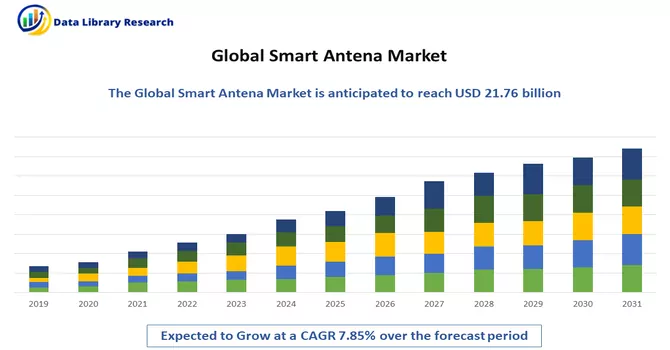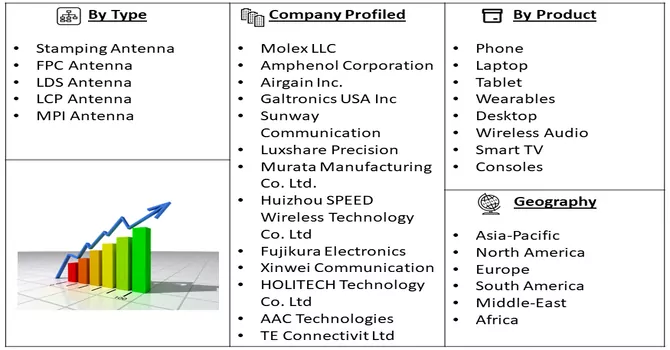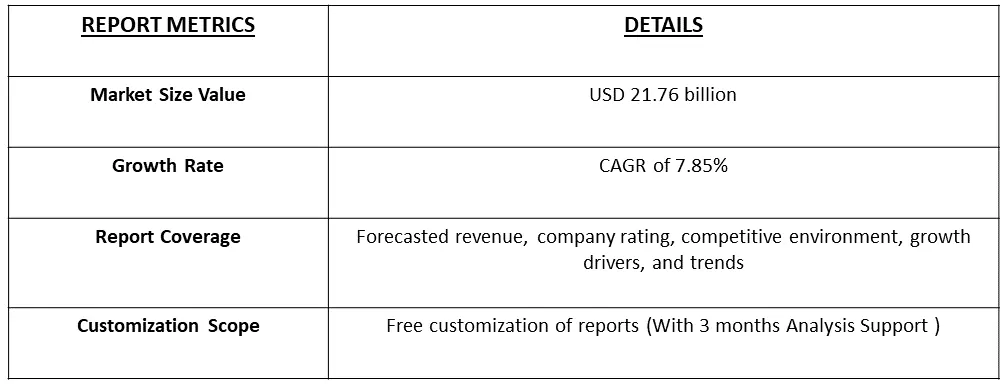The Antenna Market is poised to experience substantial expansion, with projected growth from USD 21.76 billion in 2023 at a Compound Annual Growth Rate (CAGR) of 7.85% during the forecast period spanning from 2023 to 2030.

Get Complete Analysis Of The Report - Download Free Sample PDF
A Smart Antenna, also known as an Adaptive Antenna or Intelligent Antenna, refers to an advanced wireless communication antenna system that employs sophisticated signal processing techniques to enhance its performance. Unlike traditional antennas with fixed configurations, a Smart Antenna can dynamically adjust its radiation pattern and parameters in response to changing environmental conditions and user requirements
This anticipated growth stems from various factors, including the escalating demand for wireless communication, the surge in internet usage, the advancement of smart cities, the proliferation of Advanced Driver Assistance Systems (ADAS) in vehicles, and more. The market is witnessing a notable uptrend as industry players respond to these emerging needs by innovating and introducing new products to secure a larger market share. The surge in the Antenna Market is notably linked to the increasing reliance on wireless connectivity solutions amid the ongoing digital transformation. The forecasted period is expected to see sustained growth driven by the widespread adoption of wireless systems, the proliferation of wireless communication, and the heightened integration of antennas into consumer electronic products. These products encompass a range of devices, including laptops, tablets, wearables, smartphones, and various other electronic gadgets.
The global rollout of 5G networks is a major driver for the Antenna Market. As 5G technology demands higher data speeds and lower latency, there is a substantial need for advanced antennas capable of supporting these requirements. The proliferation of IoT devices across various industries is fueling the demand for antennas. Antennas play a crucial role in connecting and enabling communication among the vast array of IoT devices, contributing to the expansion of the Antenna Market. These trends collectively depict a dynamic landscape for the Global Antenna Market, driven by the evolving needs of communication technologies across various industries and the ongoing development of next-generation wireless networks.
Market Segmentation: The Global Antenna Market Manufacturers and is Segmented by Type (Stamping Antenna, FPC Antenna, LDS Antenna, LCP Antenna, MPI Antenna), Product (Phone, Laptop, Tablet, Wearables, Desktop, Wireless Audio, Smart TV, Consoles), and Geography (North America, Europe, Asia-Pacific, Latin America, and Middle East and Africa). The report also covers market sizes and forecasts of different geographical regions.

For Detailed Market Segmentation - Download Free Sample PDF
Market Driver :
Demand for Small Cell Deployments
The deployment of small cells stands as a strategic initiative aimed at augmenting network capacity and expanding coverage, with a particular emphasis on urban areas. This deployment trend is significantly influencing the demand for antennas, as small cells rely on these crucial components to ensure efficient data transmission in densely populated environments. In urban settings, the demand for wireless connectivity is exceptionally high due to the concentration of users, businesses, and various connected devices. Traditional macrocell towers may face challenges in meeting this demand, leading to network congestion and potential service quality issues. Small cells serve as a targeted solution to address these challenges by offloading traffic from macrocells and providing localized coverage in specific urban hotspots. Antennas play a pivotal role in the functionality of small cells. These antennas are designed to efficiently transmit and receive data over shorter distances, ensuring robust and reliable connectivity within confined urban spaces. The deployment of small cells involves strategically placing these compact and discreet antennas in key locations, such as streetlights, utility poles, or building rooftops, to create a dense network of coverage.
Focus on Energy-Efficient Antennas:
The pursuit of energy efficiency in antennas aligns with broader environmental considerations and the imperative to minimize the carbon footprint associated with modern communication technologies. Energy-efficient antennas are designed to operate with enhanced power optimization, ensuring that the energy consumed aligns closely with the actual requirements of the communication system.This trend contributes to the development of communication systems that are not only technologically advanced but also environmentally conscious. By minimizing power consumption, energy-efficient antennas play a pivotal role in reducing the overall energy demands of communication networks, subsequently decreasing the environmental impact associated with energy production and consumption.Moreover, the drive towards energy-efficient antennas underscores a commitment to sustainable practices in the telecommunications industry. As these antennas become integral components of wireless communication infrastructure, their energy optimization features contribute significantly to meeting sustainability goals. In April 2023, Amphenol Airwave Communication Electronics Co. Ltd., a subsidiary of Amphenol Corporation, disclosed a strategic alliance with NuCurrent, a prominent global player in wireless power systems. This collaborative effort is geared towards meeting the prevalent industry need for transitioning to the emerging Qi2 standard, pronounced as "cheē tü." The partnership will harness NuCurrent's extensive knowledge in wireless power intellectual property, systems technology, and design capabilities, complemented by Amphenol's expertise in antenna technology, design, and manufacturing.
Market Restraints :
Reduced Signal Quality
A significant market restraint for the antenna market is the increasing prevalence of signal interference and spectrum congestion. As the demand for wireless connectivity continues to surge, the radio frequency spectrum becomes increasingly crowded, leading to interference issues. This interference can degrade the performance of antennas and compromise the quality of communication signals. Several factors contribute to spectrum congestion, including the proliferation of wireless devices, the deployment of new communication technologies like 5G, and the growing Internet of Things (IoT) ecosystem. With limited available frequency bands, the competition for spectrum space intensifies, leading to signal collisions and reduced overall network efficiency.
Segmental Analysis :
Stamping Antenna Segment is Expected to Witness Significant Growth Over the Forecast Period
Stamping antennas, also known as etched antennas or printed antennas, are a type of antenna technology that involves the use of stamping or etching techniques to manufacture antennas. This approach is characterized by its cost-effectiveness, scalability, and the ability to create antennas with specific shapes and patterns to meet diverse application requirements. Stamping antennas offer a cost-effective manufacturing solution, particularly for large-scale production. The process allows for efficient material usage and reduces production costs compared to traditional antenna manufacturing methods. The stamping process is scalable, making it well-suited for mass production. This scalability contributes to the widespread adoption of stamping antennas in industries where large quantities of antennas are required. Thus, such factors are contributing the studied segment’s growth.
Phone Segment is Expected to Witness Significant Growth Over the Forecast Period
A phone, short for telephone or smartphone, is a handheld device that enables voice communication and often includes additional features such as text messaging, internet browsing, and various applications. Smartphones, in particular, have become ubiquitous in modern society, serving as essential tools for communication, information access, and entertainment. Antennas enable wireless communication technologies like cellular networks, Wi-Fi, Bluetooth, and NFC. The quality of voice calls is influenced by the performance of the phone's antennas in maintaining a stable and strong connection. Thus, the quality of voice calls is influenced by the performance of the phone's antennas in maintaining a stable and strong connection.
Asia-pacific Region is Expected to Witness Significant Growth Over the Forecast Period
The Asia-Pacific region is experiencing a surge in demand for enhanced information sharing, in-car entertainment, and the expansion of the Internet of Things (IoT). Antennas play a crucial role in ensuring seamless wireless connectivity for high-speed communication systems, prompting leading antenna innovators in the region to provide a diverse range of solutions for various applications. These applications span industrial, cellular, 5G, automotive, global navigation satellite system/global positioning system (GNSS/GPS), healthcare, and more. A notable trend in the region is the increasing adoption of cabled external antennas known for delivering best-in-class radio frequency (RF) performance within ruggedized thermoplastic enclosures. These external antennas demonstrate resistance to moisture, extreme thermal conditions, and vibrations, making them versatile for mounting in various locations. This trend is driving market demand across the Asia-Pacific region. Antenna manufacturers in Asia-Pacific leverage their industry-leading expertise to design and manufacture custom solutions, with a focus on small multiband and complementary antennas. Technologies such as laser direct structuring (LDS), flex, stamped, and ceramic are employed to meet the diverse needs of advanced applications. Miniaturization is a key factor in enhancing antenna infrastructures, particularly in wireless and consumer electronics, allowing for smaller and lighter designs. Designers grapple with greater feature density to meet user expectations, and miniaturization enables the incorporation of more functionality into compact spaces. Collaboration and partnerships within the industry have played a pivotal role in advancing product design and preemptively addressing potential issues before production, facilitated by emerging technologies. Cloud collaboration has been instrumental in bringing together manufacturing experts to prevent costly rework cycles. State-of-the-art simulation tools empower manufacturers to make accurate predictions regarding performance and reliability. For instance, Luxshare Technology Co. Ltd., a prominent Chinese electronic components manufacturer, is at the forefront of providing data communication facilities and enterprise-level 5G-related products in China. The company's core product portfolio encompasses antennas, connectors, cables, optical modules, and interconnection products. In a strategic move, Luxshare Technology partnered with POET Technologies Inc. in February 2023 to develop a power-efficient and cost-effective portfolio of 400G and 800G transceiver solutions for data centers. The company's commitment lies in offering seamless electronic component integration into a single multi-chip module through intelligent manufacturing techniques.

Get Complete Analysis Of The Report - Download Free Sample PDF
The Antenna Market exhibits a notable degree of fragmentation, marked by the presence of several key players. This landscape is characterized by the diversity and competitiveness of market participants, each contributing to the overall dynamism of the industry. In this scenario, numerous key players operate within the Antenna Market, each bringing unique strengths, technological expertise, and market strategies to the forefront. The market fragmentation is evident in the presence of various companies specializing in different types of antennas, catering to diverse applications, industries, and emerging technologies. This competitive structure fosters innovation as companies strive to distinguish themselves through technological advancements, product differentiation, and the ability to address specific market needs. It encourages a continual quest for excellence among market players, driving the development of cutting-edge antenna solutions to meet the evolving demands of wireless communication, connectivity, and emerging technologies such as 5G, IoT, and smart cities. Some of the market players working in this market segment are:
Recent Development:
1) April 2023: Ignion, a Barcelona-based innovator in IoT antenna technology, announced a strategic partnership with Geocene, a renowned engineering and technology design firm based in California. This collaboration aims to provide robust support for the design and development of cutting-edge IoT devices, leveraging Ignion's Virtual Antenna technology and the cloud-based Antenna Intelligence Cloud. Given the intricacies of IoT development, a proficient engineering team equipped with the latest RF hardware technology is essential to expedite market entry with optimal connectivity and reliability. By joining forces, Geocene and Ignion are merging their personnel and technological expertise to facilitate successful solutions for customers grappling with intricate challenges and adapting to the ever-evolving market demands.
2) March 2023: Rohde & Schwarz unveiled their latest innovation, the R&S TSEMF-B2E isotropic antenna, designed for use with the TS-EMF measuring
Q1. What was the Smart Antena Market size in 2023?
As per Data Library Research Smart Antena Market is projected to grow USD 21.76 billion in 2023.
Q2. At what CAGR is the Smart Antena market projected to grow within the forecast period?
Smart Antena market is expect to register at a Compound Annual Growth Rate (CAGR) of 7.85% during the forecast period.
Q3. What are the factors driving the Smart Antena market?
Key factors that are driving the growth include the Demand for Small Cell Deployments and Focus on Energy-Efficient Antennas.
Q4. Which region has the largest share of the Smart Antena market? What are the largest region's market size and growth rate?
Asia-Pacific region has the largest share of the market. For detailed insights on the largest region's market size and growth rate request a sample here
Data Library Research are conducted by industry experts who offer insight on industry structure, market segmentations technology assessment and competitive landscape (CL), and penetration, as well as on emerging trends. Their analysis is based on primary interviews (~ 80%) and secondary research (~ 20%) as well as years of professional expertise in their respective industries. Adding to this, by analysing historical trends and current market positions, our analysts predict where the market will be headed for the next five years. Furthermore, the varying trends of segment & categories geographically presented are also studied and the estimated based on the primary & secondary research.
In this particular report from the supply side Data Library Research has conducted primary surveys (interviews) with the key level executives (VP, CEO’s, Marketing Director, Business Development Manager and SOFT) of the companies that active & prominent as well as the midsized organization
FIGURE 1: DLR RESEARH PROCESS

Extensive primary research was conducted to gain a deeper insight of the market and industry performance. The analysis is based on both primary and secondary research as well as years of professional expertise in the respective industries.
In addition to analysing current and historical trends, our analysts predict where the market is headed over the next five years.
It varies by segment for these categories geographically presented in the list of market tables. Speaking about this particular report we have conducted primary surveys (interviews) with the key level executives (VP, CEO’s, Marketing Director, Business Development Manager and many more) of the major players active in the market.
Secondary ResearchSecondary research was mainly used to collect and identify information useful for the extensive, technical, market-oriented, and Friend’s study of the Global Extra Neutral Alcohol. It was also used to obtain key information about major players, market classification and segmentation according to the industry trends, geographical markets, and developments related to the market and technology perspectives. For this study, analysts have gathered information from various credible sources, such as annual reports, sec filings, journals, white papers, SOFT presentations, and company web sites.
Market Size EstimationBoth, top-down and bottom-up approaches were used to estimate and validate the size of the Global market and to estimate the size of various other dependent submarkets in the overall Extra Neutral Alcohol. The key players in the market were identified through secondary research and their market contributions in the respective geographies were determined through primary and secondary research.
Forecast Model
